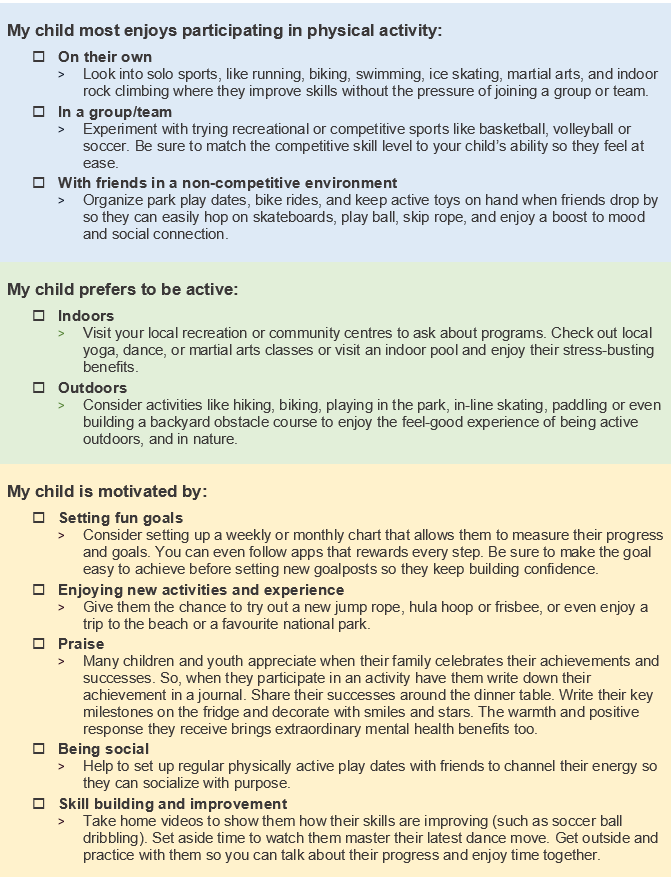
Physical activity isn’t always about being competitive or ‘sporty’, but it should always be about having fun.
To get your child excited to move, find an activity that taps into their existing interests, personality, strengths and natural talents.
When a child is having fun, getting stronger, and improving, being physically active becomes a boost to their self-confidence.
Mix it up with play, sports, games, and other activities to keep things interesting. They’ll get used to using their body in different ways while staying within their comfort zone.
Here are some great ways to play to your child’s strengths and motivations and encourage them to get moving.
Tips for finding a good fit for your child
1. Start with your child’s ideas and find ‘the hook”
Find out what your child already enjoys. Ask about their favourite activity in PE class, or on the playground. Think about what they have enjoyed playing before, and what motivates them to get moving and stay moving – whether it’s being with friends, playing in the great outdoors, or getting plenty of praise and encouragement.
Understanding your child’s existing preferences is often “the hook” you need to guide them towards enjoying physical activity.
It’s also helpful to stay curious, and ask if there is anything new they’d like to try every now and again.
Here's a quick checklist to guide you:

2. Know your child’s comfort zone
Trying something new can often bring up some level of discomfort in your child, but this should settle with positive experiences. Consider the type of activity, the environment, and the peer group and coach.
Here a few ways to ensure your child’s physical activity is still a fun, positive, and rewarding experience.
- Keep crowds in mind: Some children may not want to be in a crowded facility such as a busy swimming pool. Consider going at an off-peak time when it’s less busy.
- Find a familiar connection: Some children may feel more comfortable and less anxious joining a team or group when they join with a friend, or if they already know the coach. Ask around to find some familiar connections in your community.
- Practice first: Performing an activity in front of others can be hard for some children. Make it easier by trying activities at home first, or at your local park when it’s not too busy. Or have your child bring a trusted friend along if activities take place in public.
- Think about athletic wear: Some children can be uncomfortable and anxious with clothing or athletic wear that exposes their body too much. Tight fitting shorts or swim suits, for example, can may make some young people feel vulnerable, or as if they’re ‘on display'. Try to keep in mind all aspects of the activity before signing up and see if you can make adjustments to make your child more comfortable, such as looser clothing.
- Find supportive leaders/coaches: Great coaching can be a support and comfort to your child. But not all children respond the same way to a particular leadership style. You can talk to your child’s coach about what approaches tend to work well for your child.
3. Play to your child’s strengths
When activities complement your child’s skills and individual needs, they are more likely to enjoy and stick with them.
For example, a child who has difficulty paying attention may benefit from a sport with constant motion and excitement. A sport with too much downtime can be more difficult to stay engaged when they are on the sidelines or waiting their turn in practice.
Sports like soccer, hockey, tennis or baseball require a high level of coordination, precision, and complex ball skills. If your child struggles with the demands of a sport’s core skills, or dislikes the constant change in motion required, they may give up on themselves, or the activity altogether. Try to play to your child’s strengths when deciding on a new sport.
If your child tries an activity and does not like it, that’s ok! Young minds, motivations, and interests change over time. Keep trying different options until they find something they truly enjoy.
4. Consider session length and timing
If your child operates best in short, focused bursts of attention, look for an activity that matches their natural rhythm.
You may want to think about the best times of the day and week for you child to participate in an activity. If your child has low energy by week’s end, perhaps choose an activity that takes place earlier in the week. If medication tires them out easily, plan to be active at a time maximizes their energy and focus. Also bring along snacks, or plan on taking breaks, to maximize energy.
Tips for trying new activities
It’s important to encourage your child to try a lot of different activities, so that they develop a range of skills. If they lose enthusiasm for one activity, explore new ideas until something clicks.
Sometimes, anxiety or fear about trying a new sport or activity can hold your child back from participating.
Try out these strategies to prepare your child for their first day of a new activity:
- Do a trial run: Try out the activity at home with your child first, when the pressure is low, before they have to be active among others.
- Preview the activity: Take your child to see others participate in a chosen activity first, or show them photos or videos of people doing and enjoying the activity. They’ll get a better idea of what happens, how it all works, and get the opportunity to ask questions.
- Visit the location beforehand: Go for a test outing to make your child feel comfortable about getting to their field of play, gym, or community centre. They can get used to the drive/bus/walk, check out the washrooms, and even try out an unfamiliar playing surface, whether it’s an artificial turf field or a long indoor track.
- Break down all parts of the activity: Some children, such as those with autism spectrum disorder, find comfort in going step-by-step through all parts of an activity before they start it. Take time to walk them through the before, during, and after of any new activity. Get your child familiar and comfortable with where they are going, what happens when they arrive, how to get ready for the activity, and what to expect during the activity. Using visual cues such as social stories or pictures may help some children learn what to expect.
- Be reassuring about nervous feelings: Ask your child how they may be feeling, including any worries they may have about an upcoming activity. Remind them that they don’t have to be the best or the fastest, but that doing their best and learning a new skill is their reward for trying.
- Build in resilience: Encourage your child to persist with a sport or new activity, but don’t force it. Learning skills like perseverance can often transfer to other areas of their lives, like becoming more dedicated to school or work. Learn more about social & emotional development, here.
- Take a break: If your child is continually having meltdowns over a new activity and the experience puts too much strain on the family, it’s okay to stop. Just the experience of starting a new sport will make it easier on your child next time - for take two, or three or four!
- Care for yourself, too: It’s not always easy finding an activity that both suits your child and fits into the busy family schedule. If you’re constantly rushing around trying to make new activities work, it’s okay to pause and catch your breath. Preserving your energy is important. When you feel more at ease about managing your child’s activities, they will too.



